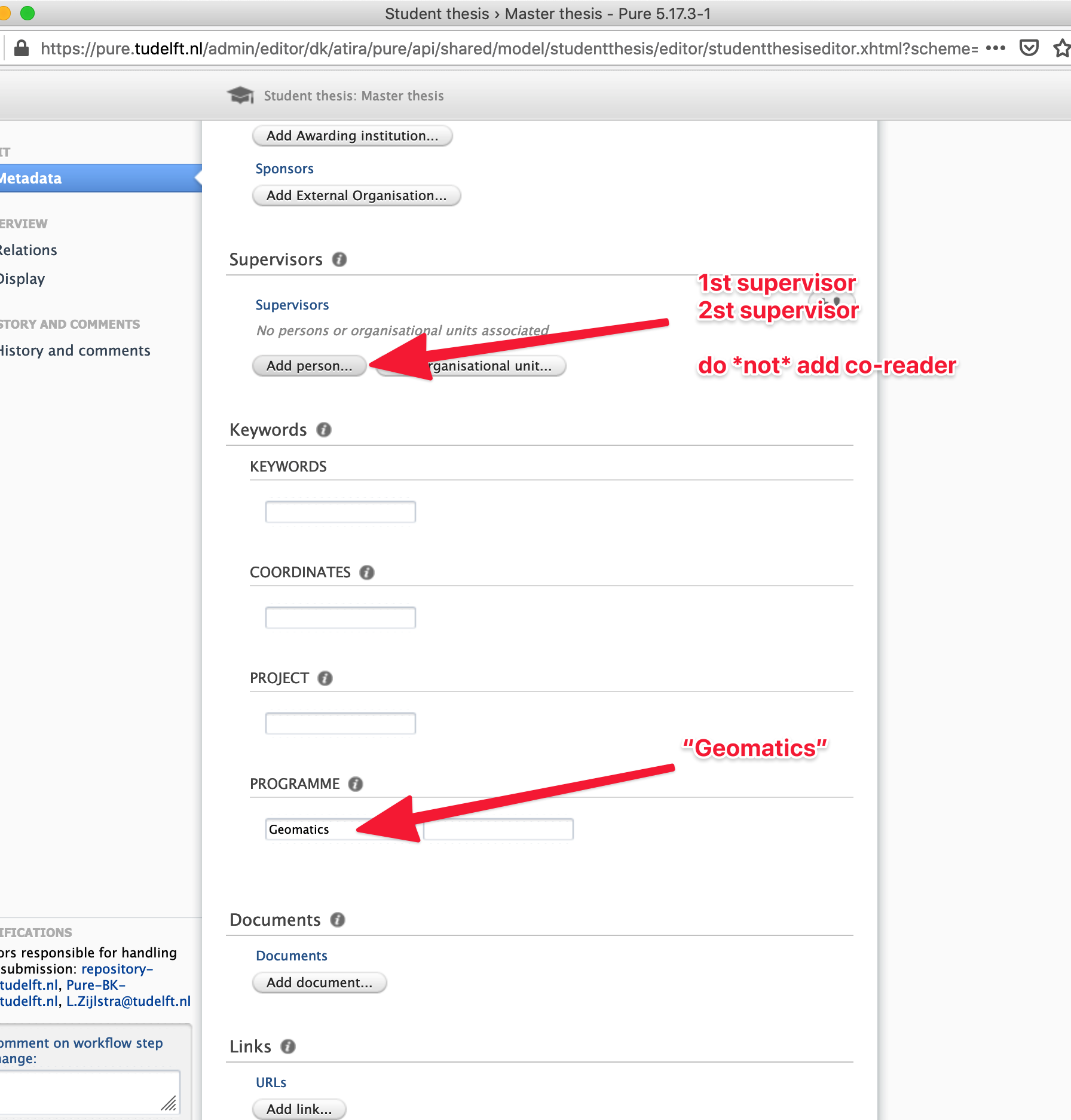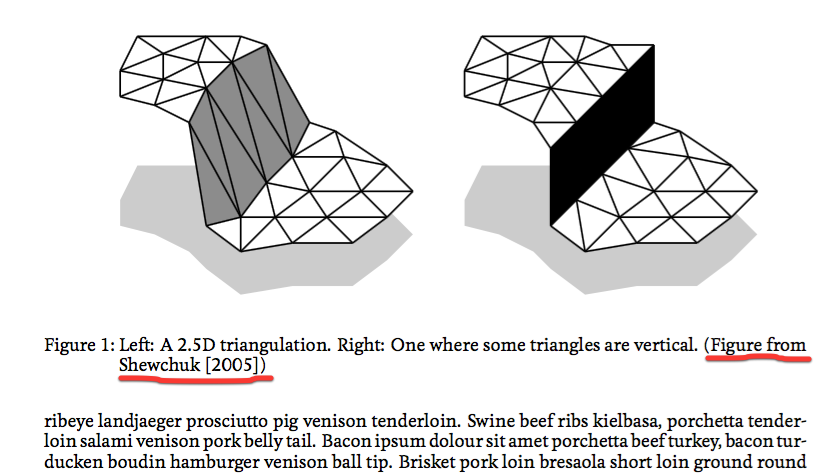- Why are there 2 separates courses? GEO2011 & GEO2020
- Which Graduation Manual apply to me?
- How do I pick a topic?
- Can I pick as First Mentor someone from another faculty?
- Is there a template for the final thesis?
- How to upload your final thesis to the TUD repository
- Can I put figures I have found in papers/theses/websites?
- Can I cite websites?
- Am I allowed to “reuse” the work of others? When does it become plagiarism?
- Who is the audience of my thesis?
- How long should my thesis be?
- Why do I need to write and submit a reflection?
- Can my thesis be written in Dutch?
- How is the final thesis evaluated by the committee?
- What is a complete draft at P4?
- What is the structure of a good thesis?
- Withdrawing from P4
Why are there 2 separates courses? GEO2011 & GEO2020
GEO2011 is for the preparation work and up to the P2 (including it). If you pass P2, you pass GEO2011 (and get the 10 ECTS). There is no grade attached to it, it’s either a pass or a fail (a retake is possible though).
GEO2020 is for the rest of the graduation trajectory; you get a grade at the end of P5 (and the remaining 30 ECTS).
Which Graduation Manual apply to me?
The Graduation Manual , and thus the rules, change almost every year. The differences are usually small, but some are significant (eg submitting a reflection, role of co-reader, etc).
You have to follow the rules of the year you started your graducation work. Even if it takes you 2 years to complete, the rules that applied when you started are the rules that apply during your whole graduation process.
How do I pick a topic?
Two options:
- you like one MSc Geomatics staff and like her/his area of research? Contact directly that person to discuss a topic.
- have a look at the potential topics offered and contact directly the person(s) listed.
Can I pick as First Mentor someone from another faculty?
No. Your first mentor, who also acts as your daily supervisor, must be a staff involved in the Geomatics programme.
Your second mentor can however be any staff of the TU Delft.
Notice that at least one of the two mentors should hold a PhD degree.
Is there a template for the final thesis?
Officially no. But we provide a LaTeX one to help you start.
How to upload your final thesis to the TUD repository
You must upload your final thesis + presentation slides maximum 1 day after your P5. This is important, if you forget you might not get your diploma!
=> Instructions to upload your thesis
To ensure that all theses from the MSc Geomatics can be easily found and that there is consistency between them, please follow these guidelines:

Can I put figures I have found in papers/theses/websites?
Yes. As long as you make it crystal clear that this is not your own figure and that you put a clear reference in the caption. Notice that if all your figures are taken from other sources, that gives the impression that you didn’t develop your own solution. Even if you redraw one figure from another paper, it is polite and good practice to cite the original source.

Can I cite websites?
Yes. If you want to reference to a piece of software or an article in a newspaper then citing the source with the URL is perfectly fine (add the date that it was last visited). Notice that it is however better to cite scientific articles and books since these have generally been peer-reviewed, and thus should be of higher quality and not contain errors. This is of course not always the case, but as general rule it’s better to cite articles first, and if there is no other sources than a website is okay.
Am I allowed to “reuse” the work of others? When does it become plagiarism?
Complex question to answer here. First, read the TU Delft position about fraud and plagiarism, and if in doubt speak to your daily supervisor.
There are serious consequences if you are caught using the work of others.
Who is the audience of my thesis?
In other words, who do I have to write my thesis for?
You should write so that your fellow students can understand your thesis: they have the same background as you have, but haven’t specialised in exactly the same area. So you don’t need to explain at length what a GIS is, but all the more advanced methods techniques you used and developed during your graduation project should be described.
How long should my thesis be?
As short as possible, but it needs to cover all the criteria in the Appendix 1 of the Graduation Manual
Writing concisely is difficult and time-consuming. Actually, it takes more time than writing long pieces. As Blaise Pascal wrote (free translation):
I would have written a shorter letter, but I did not have the time.
But since you insist on having a page number, around 75 pages is probably what is expected (with a “normal” amount of figures and tables).
This plot shows the average number of pages of MSc theses at the University of Minnesota in different fields. Geomatics is not in the list, but the average is clearly under 100, and in many fields a bit above 50.
Why do I need to write and submit a reflection?
You do not need to write a separate reflection, this does not apply to the MSc Geomatics thesis, but to other programmes at BK.
If you get (threatening) emails from the administration at BK asking for it: reply that it’s not required for your study and CC the coordinator of the thesis (Hugo Ledoux).
Can my thesis be written in Dutch?
No, it must be in English. And your presentations (P1, P2, P3, P4 and P5) must also all be made in English.
How is the final thesis evaluated by the committee?
The evaluation criteria that will be used by the committee to mark the final thesis, also called a rubric, are available in the Appendix 1 of the Graduation Manual.
What is a complete draft at P4?
The deliverable at P4 is “complete draft thesis”, and many of you asked their supervisor: “what does that mean?”. The answer to this is very subjective, and thus varies from supervisors to supervisors, so discuss this with them. The main point is that the committee needs to assess whether what has been done so far (and submitted) is at least a 6.0, if this is so then a GO is given. You then have about 1 month to improve your thesis for the P5, where a mark is given.
Some guidelines:
- the draft thesis should contain all the main results, ie there shouldn’t be essential work left
- there should be conclusions drawn based on the work done
- if not all the sentences are perfect it’s fine, but if your text is filled with typos and reading it is difficult then it’ll be more complex for the committee too assess whether the work done deserves a 6
- a tip: figures/tables/workflows can be drawn by hand on paper, and simply scanned. Between P4 and P5 you’ll have time to make nice figures.
- acknowledgements, abstract, title page, future work, tables of figures, etc. can be left for after P4
What is the structure of a good thesis?
While you’re allowed to structure your thesis you way you like it, good theses usually roughly follow this structure:
1. Introduction (~5 pages)
- What is the scientific problem you are aiming to solve? Why is it important? And why is it relevant to Geomatics? (make sure what you intend to do is in line with the overall learning objectives of the Geomatics programme at TU Delft)
- What is the main research question that you plan to answer?
- Also, an overview of the obtained results and an overview of the thesis should be given.
2. Theoretical background & related work (~15 pages)
- Overview of all the topics related to your main research question. Here you provide some context for the reader—when describing what others did, explain clearly how their work relates to yours.
- It’s also the place to explain to the reader the concepts that are necessary to understand the rest of the thesis.
3. Methodology/Experimental design and development (~20 pages)
- Describe what you did. Present the design of your experiments and/or present the algorithm/methodology you used to answer your research question.
- Observe that it’s better to separate the theory from the practice. That is, if you developed a new algorithm/method to process 3D city models, first describe this algorithm from a conceptual point of view (with pseudo-code) without discussing implementation details. These details (eg language details, classes, bits and bytes, running time), should be presented and discussed in a separate part of the thesis (a chapter about the implementation of the methodology is possible for instance).
4. Implementation and Experiments (~10 pages)
- Details of the experiments (including datasets used) and of the implementation of the methodology developed.
5. Results and Analysis (~10 pages)
- Present your results, and provide an analysis of them.
6. Conclusion, discussion and future work (∼5 pages)
- Summarise your main result and give a clear answer to the research question you defined in the Introduction.
- Discuss what did not work too.
- Give an overview of new research questions that arose during your research, or promising ideas you had but didn’t have time to investigate.
7. Appendices
- Put here any material that would break the flow of the thesis: details about datasets, extensive UML diagrams, list of tools and configurations used, etc.
- It’s possible that you have no appendix at all for your thesis.
- Except for maybe small excerpts that show specific issues, code you wrote should not be put in your thesis as an appendix.
- No one wants to read hundreds of lines of code on paper.
- Instead, put the code on a publicly accessible repository (eg GitHub) and give a link to the readers.
Withdrawing from P4
- inform your supervisors, the coreader and the delegate examiner
- send an email to the Board of Examiners (examencommissie-bk@tudelft.nl) stating your name and student number, and declare that you withdraw from P4.
- you need to refill the P4 form before the next P4 period, thus to register again.
